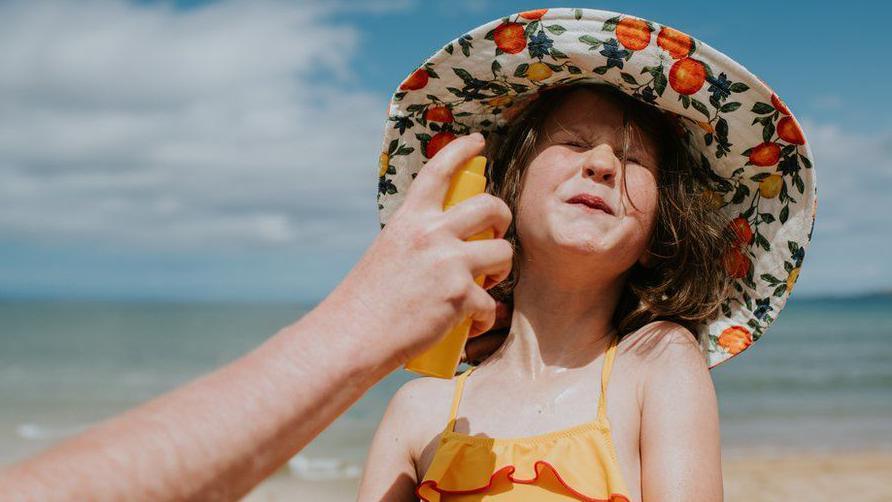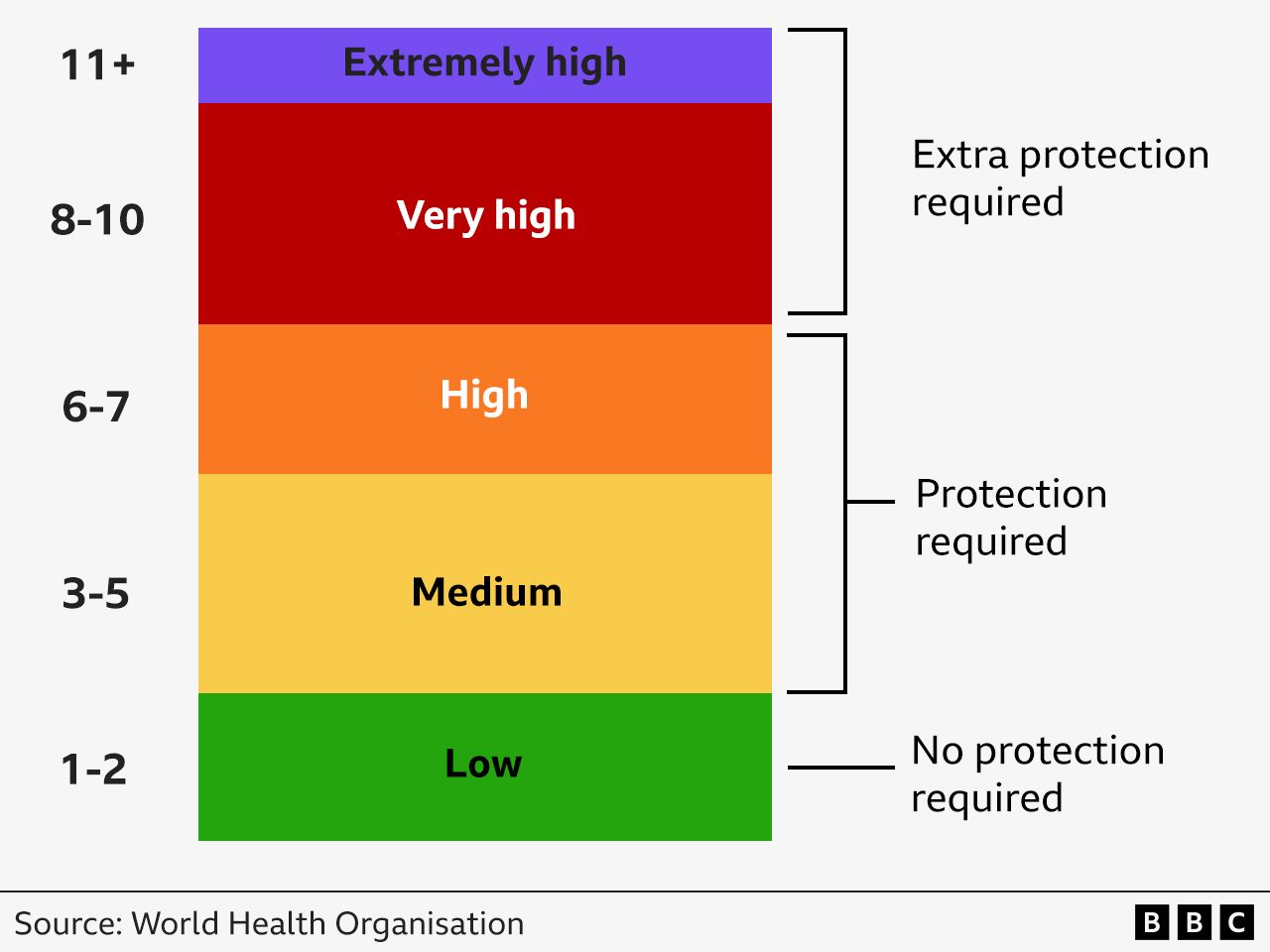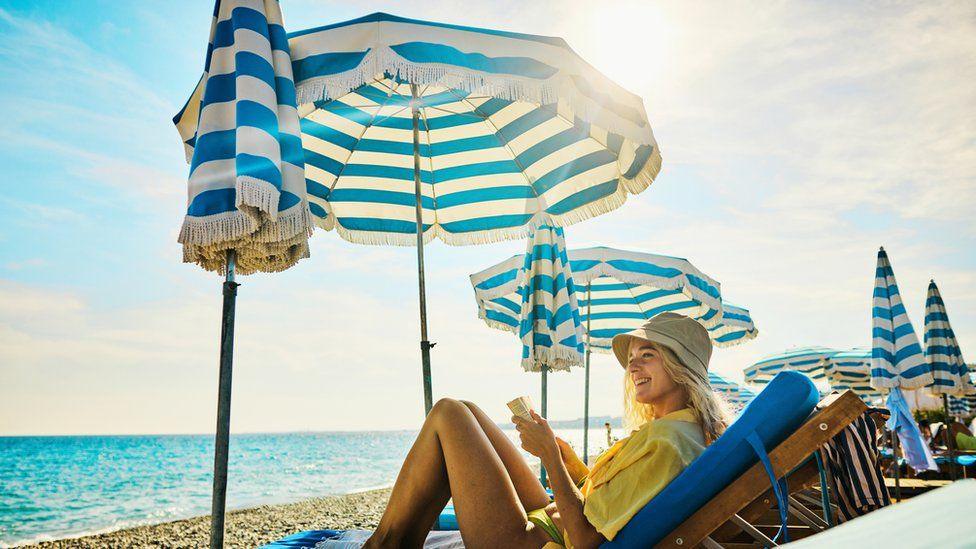How does sunscreen work, and how much do you need to use?

- Published
Experts warn that many people do not use enough sunscreen, or apply it correctly.
What is the best way to protect your skin from the sun's rays?
What are UVA and UVB, and how can they damage skin?
Ultraviolet (UV) radiation is emitted by the Sun and penetrates the Earth's atmosphere. Ultraviolet A (UVA) and Ultraviolet B (UVB) refer to different wavelengths.
Some exposure to UV radiation is beneficial, because it enables our skin to produce essential vitamin D. This is important for the function of bones, blood cells and our immune system.
But too much UVA and UVB can cause skin damage and premature ageing, and lead to skin cancer. It can also damage eyes.
Levels of UV radiation vary throughout the day.
The highest readings occur in the four-hour period when the sun is at its highest - usually from late morning to early afternoon.
The UV Index is a standard measure of UV radiation used around the world.
Values start at zero and can rise above 10.
According to Cancer Research, external, if the UV index is three or above, you should consider using sunscreen and covering up. Higher readings require more protection.

What do the SPF numbers mean on sunscreen?
The most prominent number on sunscreen bottles is the sun protection factor or SPF. The larger the number, the greater the protection.
According to the British Skin Foundation, external, the SPF rating tells you how much protection your sunscreen provides from UVB.
Correctly applying sunscreen with an SPF of 30 it means that it would take your skin 30 times longer to go red than if you used none.
The British Skin Foundation says an SPF of 30 allows about 3% of UVB to penetrate the skin and SPF 50 about 2%.
It and the NHS both recommend using sunscreen with an SPF of at least 30.

What do the star ratings mean?
Many sunscreen brands also carry a star rating from one to five.
The NHS says, external the star rating measures the amount of UVA protection, with more stars denoting increased protection. The NHS recommends using sunscreen with at least four stars.
If the letters "UVA" appear inside a circle on the sunscreen bottle, the product meets EU safety standards.
Ideally, your sunscreen should have both a high SPF rating and a high star rating.
How much sunscreen do you need?
No sunscreen provides absolute protection from UV radiation. So, you should also wear appropriate clothes, a sun hat and sunglasses, and spend time in the shade during the hottest part of the day.
In addition, sunscreen ratings assume the product has been applied in ideal conditions.
The NHS says most people do not apply enough sunscreen.
It recommends, external that adults use around six to eight teaspoons of sunscreen if they are covering their entire body.
Sunscreen should be applied to all exposed skin, including the face, neck and ears - and head if you have thinning or no hair - ideally 30 minutes before you go out into the sun.
It should be reapplied every two hours, or sooner if you sweat a lot, have been in water, or after drying yourself with a towel.
This is the case even if the sunscreen says it is water resistant, or describes itself as long-lasting.
You should take extra care to protect babies and children as their skin is much more sensitive to sun damage.
The NHS says children younger than six months should not spend any time in direct sunlight, external. Sunscreen is not recommended for this age group.
You should also take extra care around sun exposure for older babies and young children.
Once they are six months old, the NHS recommends using a sunscreen rated at least 50 SPF which offers high levels of protection from both UVA and UVB. Sunscreen should be applied to all exposed areas, and regularly reapplied.
Children wearing sunscreen should still avoid direct sunlight during the middle of the day, and wear a wide-brimmed hat and sunglasses.

The British Association of Dermatologists recommends that sunscreen is kept in a cool, dry place, out of direct sunlight, external.
It says unopened sunscreen stored correctly typically lasts around 30 months.
You should not use sunscreen which is past its expiry date as it may be less effective.
Some sunscreen does not have an expiry date but displays a "period after opening (PAO)" symbol. This is an open container next to a number indicating how long the product remains effective once in use - with "12M" meaning 12 months.
What should you do if you get sunburned?
Sunburn results in hot and sore skin which may peel after a few days. In extreme cases, skin can blister.
It usually gets better within a week or so, but there are things you can do to ease the symptoms.
The NHS recommends, external getting out of the sun as soon as possible, and keeping burned skin covered to protect it from the sun until it has fully healed.
A cool shower or a damp towel can help, as can moisturising aftersun products, painkillers and drinking plenty of water. Ask your pharmacist for advice.
You should not put petroleum jelly or ice on sunburned skin. You should resist scratching the burned areas and avoid tight-fitting clothes.
Contact your GP or NHS 111 if your skin is blistered or swollen or you have other symptoms of heat exhaustion or heatstroke.
Regularly getting sunburned can increase the risk of skin cancer.